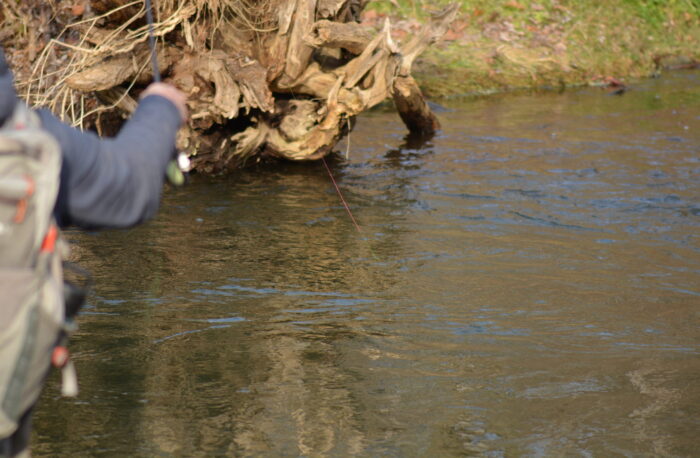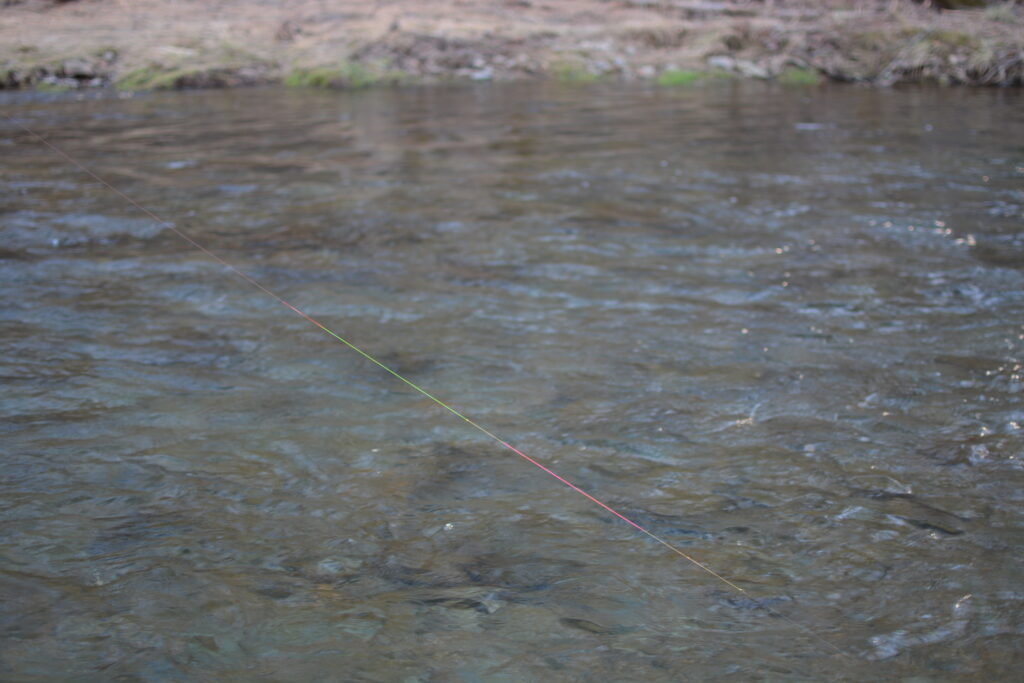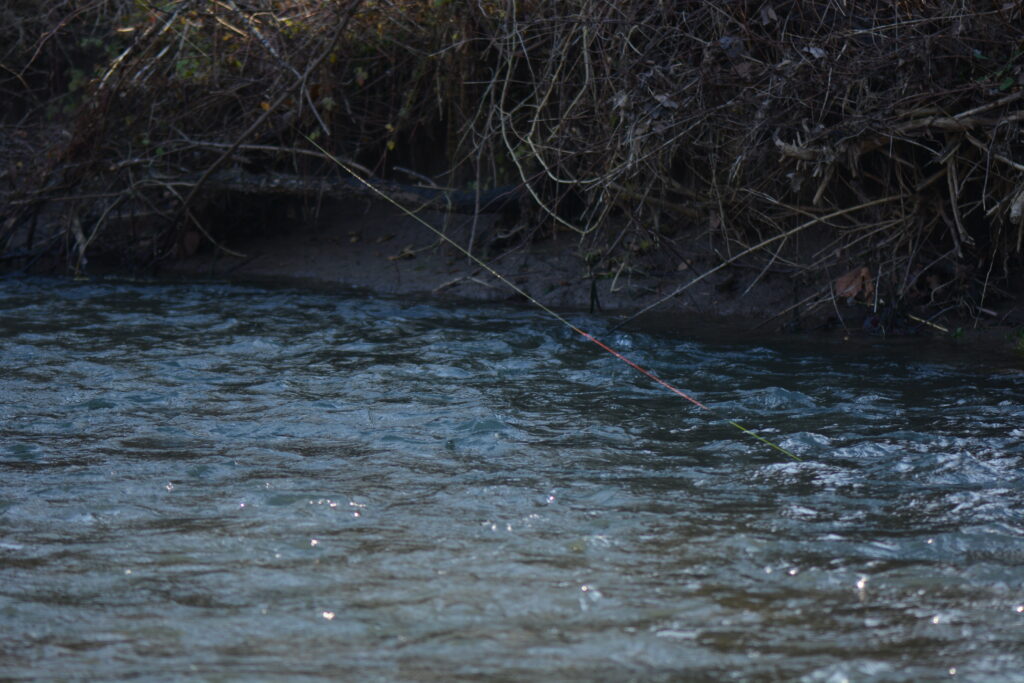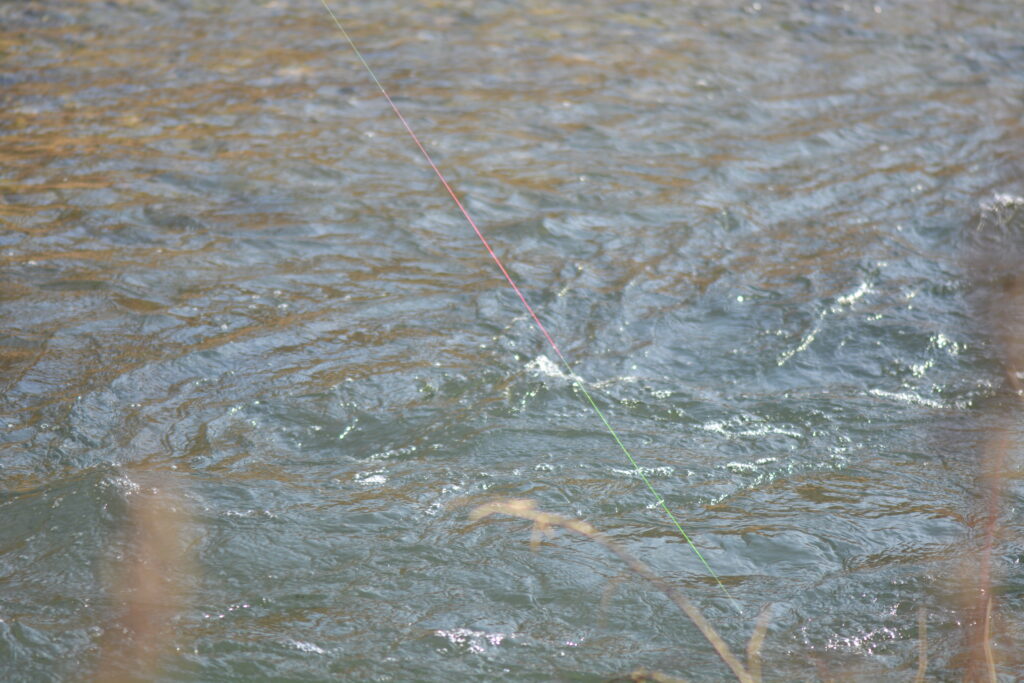
What to Do When You’re Missing Fish
I’ve found that the days I miss the most fish are when they’re not all on the same feeding pattern. Times when they’re eating throughout the column and willing to move far and fast for food. Trout in these situations tend to intercept your fly before you can come tight, and generally move a bit quicker, resulting in short, nippy strikes. This can be incredibly frustrating to deal with. You know the fish are happy and that you’re showing them the right thing, you just can’t get a hook in them.
The first thing to do in this situation is target the different levels of the column individually. Focusing on specific depths helps reduce the margin of error, but that’s not always enough. Missing fish on these sorts of days boils down to having too much slack in the system. If you cover the column without considering the contact you can use at the different levels, you could still be leaving a lot of fish on the table. It’s not always best to show them a perfect drift, often it’s better to present a passable drift that stacks the odds of a hookup in your favor. It took me a while to fully understand this, but I eventually came up with a system that made sense to me, which I now call the three tiered approach.
What is the three tiered approach?
I was originally taught to fish the whole water column by U.S. Youth Team coaches Paul Borque and Gordon Vanderpool. They were masters of covering the different levels of the river with high, medium, and deep drifts, and managed to teach me how to do it half decently. I had a lot of success using the techniques they showed me, but still struggled with missing strikes. Through a lot of time on the water and tips from fellow anglers I found that this was a result of not maximizing contact with the fly where I could.
I eventually started accounting for slack while fishing different levels of the column. As I condensed and streamlined these techniques in the search for the most efficient method, I ended up with the three tiered approach. In essence, it’s a method for covering all the levels of the column and levels of fish activity in as few casts as possible. It works on the theory that the higher up a fish is willing to feed, the more active it is and the more willing it may be to eat a faster drift. Fishing a faster drift means you have more contact and a better chance to convert a strike. By starting with as much contact as possible and working down to more natural drifts you minimize the possibility of missing fish.

Like the name implies, the three tiered approach has three parts. It starts with tier one, a fast, low angle, high contact drift near the surface for the most active fish. When that level has been cleared, you move to tier two with a mid level, mid speed drift to catch the fish that didn’t want to move all the way up or eat a fast presentation. Finally, in tier three you move to a more standard drift, letting the fly reach the bottom and drift slower for the least aggressive fish.
I primarily use this technique while fishing a single fly, as it’s harder to manage the depth of two flies at once. Aside from that it’s not a technique that needs specific flies or rigging; it can be used at any point you want cover an area more thoroughly. It works best fishing a rod length across and one to two rod lengths upstream, give or take a bit. Further across and it’s a struggle not to pull the flies across the currents. Facing more upstream works well, but requires more work with the rod tip and line hand to keep the fly moving the right way. I’ll mainly be focusing on the one across, two upstream scenario, but the logic holds the same for any angle.
Related- Wade Before You Cast: Use Positioning to Catch More Fish
Tier 1
Tier one is the fast, low angle drift in the upper part of the water column. It targets the most active fish that may be willing to eat a fly speeding past. These are not only the fish that are sitting high in the column, but also more aggressive fish that are sitting mid column or lower and willing to move all the way up to eat.

The presentation starts out with a cast that keeps you tight to the fly. A tuck cast or any sort of fly first entry will put too much slack into the initial presentation, both sinking the fly too far and giving aggressive fish a chance to strike before you can get connected. I prefer to use an oval cast perpendicular to the water, which slaps the fly onto the surface while maintaining a tight connection to the rod tip. If for whatever reason that’s not possible, a more traditional cast will work, as long as you maintain control and use a shallow angle. I fish the fly around six inches under the surface. Depending on the fly weight, tippet length, and speed this is accomplished with a fifteen to thirty five degree angle between the line and the water.
The moment the fly touches the water, I begin leading it downstream to keep a straight connection. At close range the lead can be done with just the rod tip, but longer casts may require you to use your line hand as well. You want to keep it moving at surface current speed or slightly faster, at least fast enough to keep up with the shallow angle. I usually end the drift when the fly reaches my position or a few feet above, as it’s hard to maintain the right depth and speed when the fly gets close.
Since you’re already pulling it downstream, it’s much easier to come tight to a fish right as it eats. I have a lot of fish actually hook themselves on this drift, leaving no opportunity to miss a strike. I’ll run the tier one drift through a spot only once or twice; any fish active enough to eat it is going to do so on its first opportunity.
Tier 2
Tier two is the middle of the road drift, having a slightly steeper angle and slower lead than tier one. It’s for the fish feeding in the middle of the column or lower that weren’t interested in moving all the way up or taking the faster drift.
If I’m fishing a relatively shallow (three feet or less) piece of water I stick with the perpendicular oval cast, but if it has any depth or speed I go for a more traditional cast. When the situation calls for it I will throw a little slack in and give it a split second pause to quickly sink the fly to the middle of the column. If the tier one drifts went well, you will have caught any fish aggressive enough to eat right when the fly hits the water, so there’s no need to be tight right at the end of the cast.

I finish the cast with my rod tip positioned so that there’s a forty to fifty degree angle between the water and sighter when the fly reaches depth. When it’s at the right level, I begin leading at a speed that maintains the sighter angle without tugging too much on the fly. It should be around eighty percent of the surface current speed. Since it’s a bit slower drift and targets less active fish, I’ll run it through the area two to three times.
Tier 3
Tier three is your standard drift. It targets fish near the bottom not interested in rising for a mid-speed presentation. On the average day I’m using the three tiered approach, I find tier three accounts for some majority of the fish. There’s usually just more fish saving energy and feeding in the slower bottom current. These fish may not want to move far up to eat, but they’ll still eat a fly quickly if it’s close by.
This is a much more open ended presentation than the last two. There’s too many different deep drifts that work well on different days to say one is always my go-to. Usually I will play around and whatever deeper drift seems most productive becomes my tier three for the outing. My most common tier three drift would be something like a fifty degree sighter angle with a slight bow in it, moving about sixty percent of the surface current speed. There’s a lot you can change, you just want to keep it near the bottom and relatively slow to differentiate it from the first two drifts. Depending on the day I will put two to five of tier three drifts through a spot.

Beyond the approach
The three tiered approach is by no means a new technique or way of fishing. In fact, I think most of the anglers and coaches I worked with back in the day were doing something similar. This approach is just my way to conceptualize it all and put the techniques into an efficient package. It’s more about the reasoning behind making each drift and condensing the process down than about the drifts themselves.
If nothing else, it’s a starting point. It shows the fish at each level a drift they’re likely to eat while maximizing contact for the anglers benefit. It works more consistently than any other tactic I’ve tried for the situation described. When I’m missing a lot of fish and have reason to believe they’re feeding up, it’s the first thing I try. That being said, it certainly doesn’t work all the time. Some days the trout are feeding in the upper column but want a slow drift or swing, others they’re all on the bottom but want the fly moving fast. When they’re extra tough I may add a tier to break the column down even further. On easier days just two tiers may be more efficient. Next time you find yourself missing more strikes than normal, give it a try and see if you can bag an extra fish or two.
Keep it tight,
-Mike Komara

Very informative, Mike. Thanks for the great ideas.
You’re welcome Alex, thanks for the kind words!